



A supernova...
...is a stellar explosion that is extremely luminous and causes a burst of radiation that often briefly outshines an entire galaxy, before fading from view over several weeks or months. During this short interval a supernova can radiate as much energy as our Sun is expected to emit over its entire life span. The explosion expels much or all of a star's material at a velocity of up to 10% of the speed of light, driving a shock wave into the surrounding interstellar medium. This shock wave sweeps up an expanding shell of gas and dust called a supernova remnant.
Significance:
-
-Brightness of standard SN are used to calculate distance, and thus the size of the universe and its rate of expansion.
-
-Close instances have profound influences on life.
Types:
-
-Type 1A result from binary star systems in which a white dwarf accrets matter from its companion.
-
-Type 2 results from the death of a star that has consumed its core.
SN 1006:

A new star, likely the brightest supernova in recorded human history, lit up planet Earth’s sky in the year 1006 AD. The expanding debris cloud from the stellar explosion, found in the southerly constellation Lupus, still puts on a cosmic light show across the electromagnetic spectrum. This debris cloud appears to be about 60 light-years across and is understood to represent the remains of a white dwarf star. Part of a binary star system, the compact white dwarf gradually captured material from its companion star. A buildup in mass finally triggered a thermonuclear explosion that destroyed the dwarf star. Because the distance to the supernova remnant is about 7,000 light years away, that explosion actually happened 7,000 years before the light reached Earth in 1006. Shockwaves in the remnant accelerate particles to extreme energies and are thought to be a source of cosmic rays.
SN 1987A (‘after’ and ‘before’ shot):
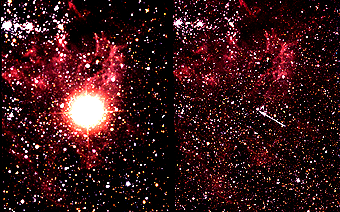
SN 1987A was found in the outskirts of the Tarantula Nebula in the Large Megallanic Cloud, a nearby dwarf galaxy. It occurred approximately 168,000 light years from Earth, close enough that it was visible to the naked eye from the Southern Hemisphere. Light from the new supernova reached Earth on February 23, 1987. As it was the first supernova discovered in 1987, it was labeled “1987A”. It was the first opportunity for modern astronomers to see a supernova up close and observations have provided much insight into core-collapse supernovae. Voyager 2, then en route to Neptune, was able to observe the supernova with its cameras.
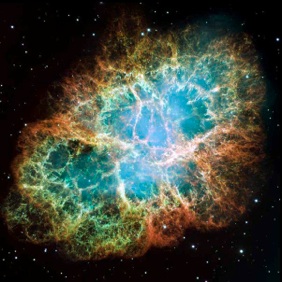
The supernova which produced the Crab Nebula was observed by the Chinese in 1054 AD. It contains the fastest known pulsar at 0.033 seconds period.
A Type 1A supernova shown exploding in the lower left hand corner of the galaxy NGC 4526 as seen by the Hubble Space Telescope.

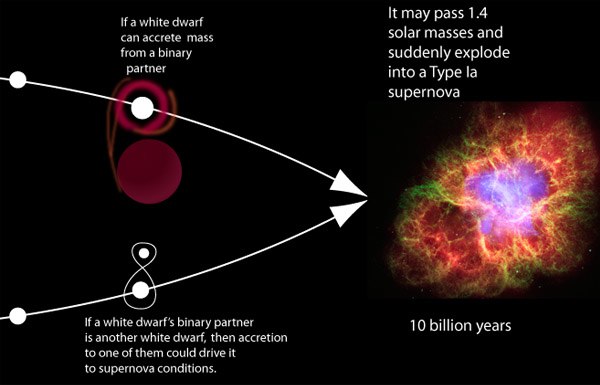
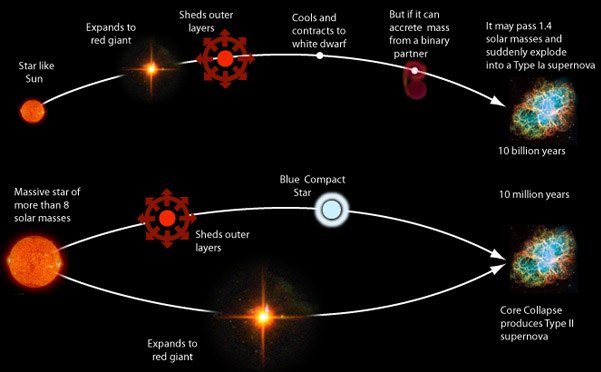
A Type Ia supernova results from the violent explosion of a white dwarf star, which has completed its normal life cycle and has exceeded the Chandrasekhar mass limit of 1.4 times our sun’s mass. A white dwarf can reach this large mass if it gradually transfers mass from a binary companion; its core will reach the ignition temperature for carbon fusion. Within a few seconds of initiation of nuclear fusion, matter in the white dwarf undergoes a runaway reaction, releasing enough energy to create a supernova explosion. A Type 1A produces consistent peak luminosity because of the uniform mass of white dwarfs that explode via the accretion mechanism. The stability of this value allows a standard luminosity to be used as a “standard candle” (see below).
Type II supernovae occur at the end of a massive star's lifetime, when its nuclear fuel is exhausted and it is no longer supported by the release of nuclear energy.
If the star's iron core is massive enough, it will collapse and become a supernova.
These types of supernovae were originally classified based on the existence of hydrogen spectral lines. Type Ia spectra do not show hydrogen lines, while Type II spectra do.
before
after



STANDARD CANDLES

If we know the luminosity of the ‘candle’ (supernova) & how bright it appears, we calculate how far away it is.
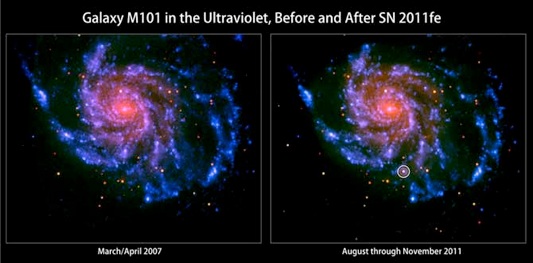
The link to original paper David Branch, Caltech: “Type 1a Supernovae as Standard Candles” in Annu. Rev. Astrophys. 1992. 30: 359-389.
The link to the list of currently observable supernovae, with other news and images.
The link to IAU Central Bureau for Astronomical Telegrams list of current supernovae (Chronologic detailed list of supernovae)
The link to the Katzman Automatic Imaging Telescope (Prof. Alex Fillipenko, University of California - Berkeley Astronomy Dept.)
The link to the Wise Observatory (Tel-aviv University and the Smithsonian Institute)
The link to the Supernova Cosmology Project (Saul Perlmutter, Lawrence Berkeley Laboratory, University of California - Berkeley)
